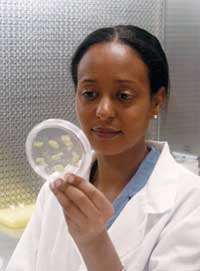Knoxville, Tennessee
August 22, 2005
A team of researchers with the
University of Tennessee
(UT) has discovered a unique plant gene that may alter research
and production of genetically modified crops.
|
 |
|
Ayalew examines plant tissue regeneration from leaf
discs transformed with the plant marker gene. Photo by
R. Maxey, The University of Tennessee Institute of
Agriculture. |
In a paper to be published in the September issue
of
Nature Biotechnology, UT plant scientists Mentewab Ayalew and
Neal Stewart document the first use of a plant gene as an
antibacterial selection marker. Selection markers are invaluable
tools for producing genetically modified plants.
“Our discovery of a plant-based selection marker will certainly
impact the public debate over the use of genetically modified
crops,” Stewart said. “It has the potential to make genetically
modified crops more attractive to markets overseas.”
Since the 1980s researchers have been pairing genes for
desirable plant traits with bacterial markers and inserting them
into target plants. By using bacterial genes resistant to
certain antibiotics as markers, researchers can separate
genetically modified plants from parent tissue. The genetically
modified plants exposed to the antibiotics live while parent
tissue is killed.
However, inserting bacterial selection markers into plant
genomes has raised questions about the possible transfer of the
engineered genes. The theoretical risk is an increase in
antibiotic resistance in bacteria that might come in contact
with modified plants, which could lead to human health risks.
“Because our marker originates from a plant, it is highly
unlikely any horizontal gene transfer would result in
antibiotic-resistant bacteria,” Stewart said. Concerns over the
biosafety of genetically modified crops are among the chief
objections to their production and sale. Both researchers say
their discovery will influence scientific debate about
genetically modified crops and be a valuable open-source tool
for researchers worldwide.
Stewart holds the Racheff Chair of Excellence in Plant Molecular
Genetics in the UT Institute of Agriculture and is the author of
the book Genetically Modified Planet (Oxford University Press,
2004). Ayalew holds a post-doctoral appointment in the UT
Department of Plant Sciences.
Their paper, “Overexpression of an Arabidopsis thaliana ABC
transporter confers kanamycin resistance to transgenic plants,”
is available in the August 21 advance online version of
Nature Biotechnology.
Further research involves monitoring the gene’s expression in
canola and other mustard species as well as investigating its
activity in bacteria.
Click here for a PDF explaining two theoretical pathways for
horizontal gene transfer (89 KB)
Related news release from
Nature
Replacement found for bacterial DNA
in transgenic crops
Possible spread of antibiotic
resistance to gut bacteria squelched by using weed genes.
Roxanne Khamsi, Nature
Scientists may have developed
a potentially less controversial way to bioengineer plants, by
replacing a marker gene normally borrowed from bacteria with a
gene from weeds. The new technique could make genetically
modified crops less contentious in places such as Europe, the
team says.
Modern technology allows
experts to mix and match DNA from different organisms to enhance
favourable crop properties; a gene from fish, for example, can
make tomato plants frost resistant.
Most transgenic crops also
contain a bacterial gene, which helps researchers distinguish
between plants that have successfully picked up foreign genes
and those that haven't during crop development. The two genes,
one for the favourable trait and one for antibiotic resistance,
are tacked together and inserted into seeds. When the growing
plants are then doused with antibiotic, those that haven't
picked up the foreign genes die off.
The marker gene typically
comes from the Escherichia coli bacterium. But critics of
the technology have pointed out that the code for antibiotic
resistance could hop, in a process known as horizontal gene
transfer, from the bioengineered food we eat into the bacteria
that live in our gut, thereby creating a superbug and a health
menace.
Gene for gene
Some companies take an extra
step to remove the antibiotic-resistant gene before marketing
their seeds. But this doesn't always happen.
Now Neal Stewart and Ayalew
Mentewab of the
University of Tennessee
in Knoxville, Tennessee think they have a more foolproof way to
eliminate this threat, which involves scrapping the E. coli
gene and using one from a plant instead.
A gene called Atwbc19
in the well-studied weed Arabidopsis thaliana also
confers antibiotic resistance; when this gene is expressed at
unusually high levels it helps to capture and squelch antibiotic
compounds.
Stewart and Mentewab designed
a piece of DNA including this gene and another that codes for
blueish pigments, making plants that pick it up easily
identifiable. The Atwbc19 gene is three times larger than
the antibiotic-resistance gene from bacteria. Both the large
size of the gene and the fact that it comes from plants makes it
less likely to hop into microbes, they say.
Weeding out fears
To test whether the
Arabidopsis gene worked, they incorporated the linked genes
into tobacco plants; the tobacco seedlings with the
Arabidopsis gene continued to grow when blasted with
antibiotics. The results appear in the journal
Nature Biotechnology.
Microbiologist Michael
Syvanen of the University of California, Davis agrees that the
study could calm fears about GM crops, particularly since the
plant gene simply can't be expressed by bacteria. "It produces a
gene which, if displaced by horizontal gene transfer back into
bacteria, would never be able to confer resistance to
antibiotics," he says.
The technique could be
adopted in parts of the world that have remained skeptical about
bioengineered foods, suggests Stewart. "There would be some
interest, especially in Europe, to move away from a bacterial
gene towards a plant gene," he says. But he cautions that
further testing is needed. Scientists must demonstrate, for
example, that the protein made from the weed gene has no
negative effect in humans.
Reference
Mentewab A. & Stewart C.
Nature Biotechnology,
Advanced Online Publication. doi: 10.1038/nbt1134 (2005). |